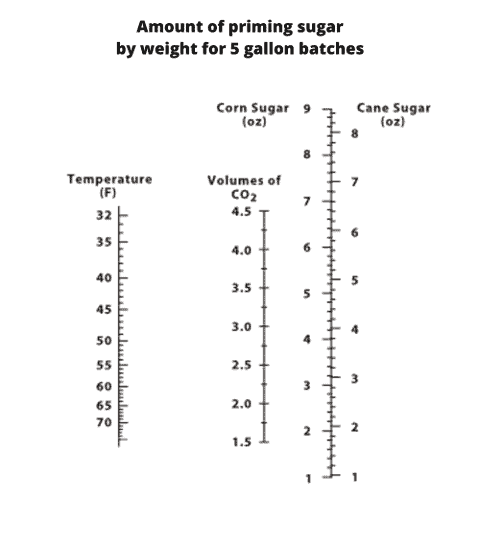Brewing, in theory, seems like a very straightforward and simple process, add the ingredients, wait and let it ferment.
If you are just starting out brewing your own beer, you probably even have most of the equipment and basic ingredients in your home already.
The thing I’ve found is that when you start brewing beer at home, you think that things are much more complicated than they actually are.
Take priming sugar for example. We could buy overpriced priming sugar at a brew shop or, could we just raid our kitchen larder?
In fact, you can use regular sugar for bottle conditioning beer and it won’t change its character much. In the bottle, the dormant yeast needs additional nutrients (sugars) to start another fermentation & carbonate your beer. Regular table sugar can do this just as well as commercial priming sugar.
So you can absolutely use the sugar that you have lying around the house and the one you use for your morning cup of coffee.
But as the curious and inventive brewer you are, you always want to make the tastiest beer, so what sugars are best?
Below, I will explain all that you can you use to brew your beer and how to do it.
What household sugars can you use for bottle conditioning beer?
It seems that the best type of sugar molecule for yeast metabolism is maltose, but really any thing from glucose to molasses will also work to different degrees. So, the answer really is that anything you have in your cupboards would probably work just fine.
Keep it fresh
The main types of sugar people use are white cane sugar, brown sugar, honey, molasses, and for those in the North-Eastern states and Canada, even maple syrup.
As everything you use should be fresh, take advantage of what’s around you like in the South molasses is something that can be easily acquired, and add depth.
My very first brew ever called for honey as the bottle conditioning fuel.
Know your sugars

All of these different types of sugars will add different properties to your beer and can change them drastically, so know your sugars as they are not all created equal.
Some of these dark sugars can give a light aftertaste and are would be used in a heavier, darker beer or even a brown ale or porter. So, a fun thing to do is to test different sugars on the same beer recipe over several weeks or even to split your batch into test groups and use different sugars for a number of bottles.
The simple sugars, like corn and cane sugar, are the most commonly used to brew with. People use corn more than cane sugar in most places because of the accessibility and price.
You will not find anything cheaper in the states than corn sugar. When these two are used though, they are often used in conjunction with malt extract for some flavor.
For its weight, cane sugar generates a smidge amount more of CO2 than corn sugar. But both of these sugars will carbonate, so I’ve been told, more than malt extract and that’s another reason they aren’t usually used on their own.
Using honey
Since there is little to no regulation on honey in the states it is difficult to use. When you get it fresh from a supplier there will not be a concertation level on the jar.
If you buy it in the store, most honey is actually just white sugar, food dye, and some real honey so make sure to read the labels if there is one.
With the gravity being different from jar to jar you will need to dilute it and use your hydrometer to measure. Then, you’ll need to compare it to your regular sugar’s SG for a reference.
New to homebrewing? Please feel free to read my ultimate guide to brewing beer at home and where to start.
What about malt extract?
Although malt extract is a great source of sugar for your wort, it doesn’t seem to be such a popular choice for priming. But maybe it should be.

In his book “How to Brew“, John Palmer gives a recipe for a priming solution using malt extract as well as other sugar sources.
Sugar | Proportion | Ounces | Grams |
|---|---|---|---|
Dry Malt Extract | 1 1/4 cups | 181 | |
Corn Sugar | 3/4 cup | 4 | 113 |
White Sugar | 2/3 cup | 5.3 | 150 |
Honey | 1/2 cup | depends on SG | depends on SG |
You should boil the quantity of sugar in the table above in about 2 cups of water.
How carbonated should beer be?
Carbonation levels of beer will depend on, well, the type of beer you are brewing.
The more active yeast that’s left in the beer and the amount of priming sugar you add with determine how much CO2 is produced within the bottled beer.
Below is a rough guide to the range of CO2 volume you should be aiming for in various beer varieties (source -J. Palmer).
Beer style | Volume of CO2 |
|---|---|
British Ales | 1.5 – 2.0 |
Porter | 1.7 – 2.3 |
Stout | 1.7 – 2.3 |
Belgian Ales | 1.9 – 2.4 |
American Ales | 2.2 -2.7 |
European Lagers | 2.2 – 2.7 |
Belgian Lambic | 2.4 – 2.8 |
American wheat | 2.7 – 3.3 |
German Wheat Beer | 3.3 -4.5 |
In the book, Palmer has a handy Nomograph (chapter 11) which gives you the right quantity of sugar for different carbonation levels.

You should draw a line from the temperature of your beer to the desired volume of CO2 (for example: a British ale, 1.5 – 2.0) then to the scale for the weight of sugar.
For example, a beer at 45 °F for a desired volume of CO2 of 3.25 would need 4.6 oz of corn sugar for 5 gallons of beer, or about 4.3 oz of cane sugar.
How to make a substitute for commercial priming sugar
There are easy ways to make a substitute for commercial priming sugar. (buy beer from local breweries)
So as you know the best way to mix in your priming sugar is to do it before bottling. This way you can be assured that all of the beer is carbonated to the same level.
If you did choose to do it bottle by the bottle it will probably not all be the same unless you have a full-proof method of transferring the sugar.
Not only is it more time-consuming to do it this way, there is also the risk of bacterial infection because the sugar solution hasn’t been boiled and sanitized.
So, here are the basics steps below after you have sanitized and cleaned all of the surfaces of your fermenter and bottles first.
Here is a website that will allow you to put in your numbers and give you a good number on how much priming sugar you need for your brew.
Are carbonation drops better than normal sugar?
As with everything it is a personal preference, funds, and access to materials.
In my own experience, I found that carbonation drops didn’t give me a consistent carbonation across all my beers; not in the same way as when I just add sugar to the bottling bucket holding the entire batch.
I do have to admit that during the repetitive task of bottling my beer I did occasionally forget to add the carbonation drop, and perhaps even added an extra one by mistake at times.
This being said, just through my own experience I always prefer to add sugar directly to the beer before racking it into bottles. But that’s just me, you should experiment and make up your own mind.
Here are the pros and cons of carbonation drops but I would recommend giving them a try.
Pros
- They are consistent and will give the same carbonation from bottle to bottle unless you drop too much in.
- Saves you time as you can skip a whole section and not to mention the cleaning of those materials.
- If you forget one you only have one less beer.
Cons
- It could be costly or hard to find depending on where you live.
- Easy to forget and lose. If either happens during bottling you could be in a little trouble.
- Purists will look down upon your beer sometimes but don’t listen to anyone it is your beer.
How long does it take to bottle condition beer?
The amount of time will depend on what type of beer you are trying to brew.
In general 2-4 weeks is standard but it is different for all of them. The standard will be about Ales 2-4 weeks and could take up to 12 weeks for something like a lager.
If possible, you should keep bottled beer in the same conditions it was fermented in, if you haven’t already built yourself a fermentation chamber, please see my article for more details.
When storing the beer you want to take proper precautions of course.
Temperature- You need a specific temperature for the type of beer you are conditioning and not only that temperature you need to be constant for the whole time. You do not want large or any swing in temperature.
Check out my article here on the best way to ensure your bottled conditioned beer turns out perfectly.
Storage- If you are in a larger home this will be easier for you but a small apartment you will have to be careful.
You want it somewhere where people will not disturb it and out of the sunlight. A plastic bin, cardboard box, cabinet, etc. are good places to store it.
You can read my article here to learn more about it.
Brewers wishlist
I don’t know about you, but there are always equipment I would love to have in my home brewery, here are a few things on my Amazon wishlist right now!
Dual tap Kegerator

Add it to your Amazon wishlist
15 Gallon all-in-one brewing system

Add it to your Amazon wishlist
Inkbird IPB-16s

Add it to your Amazon wishlist
Kegco 3PXBK30-T2 30 Gallon Kettle

Add it to your Amazon wishlist






